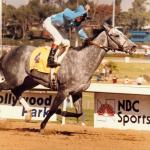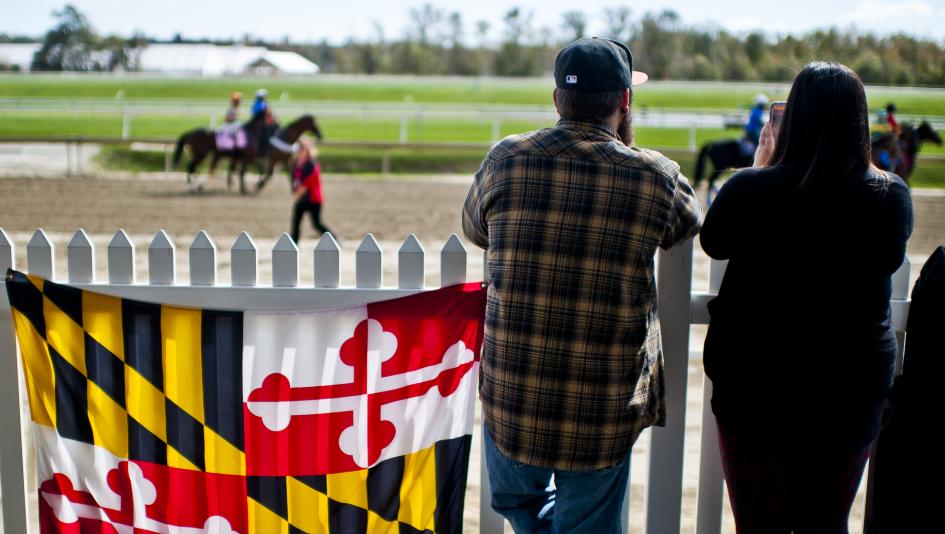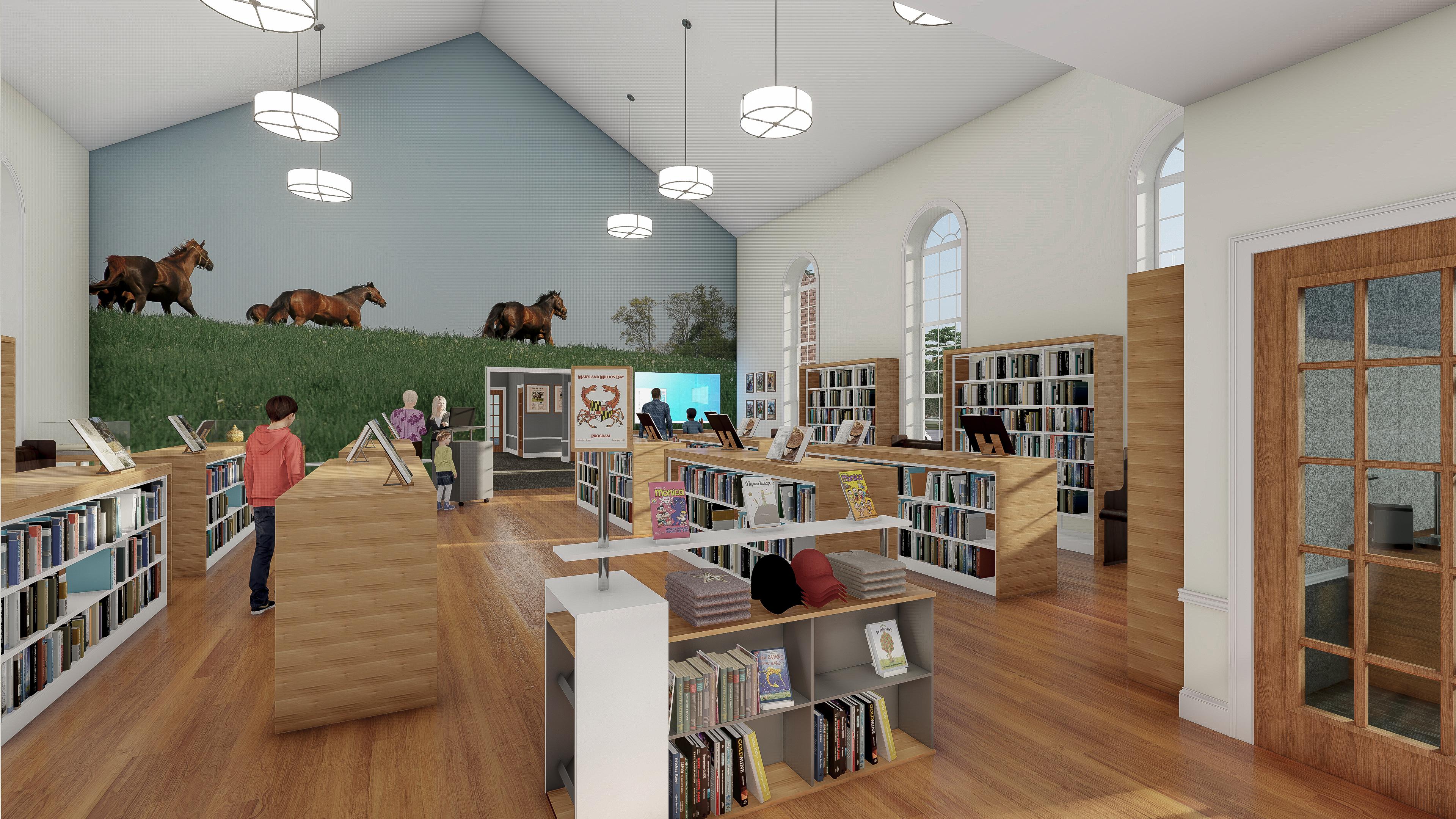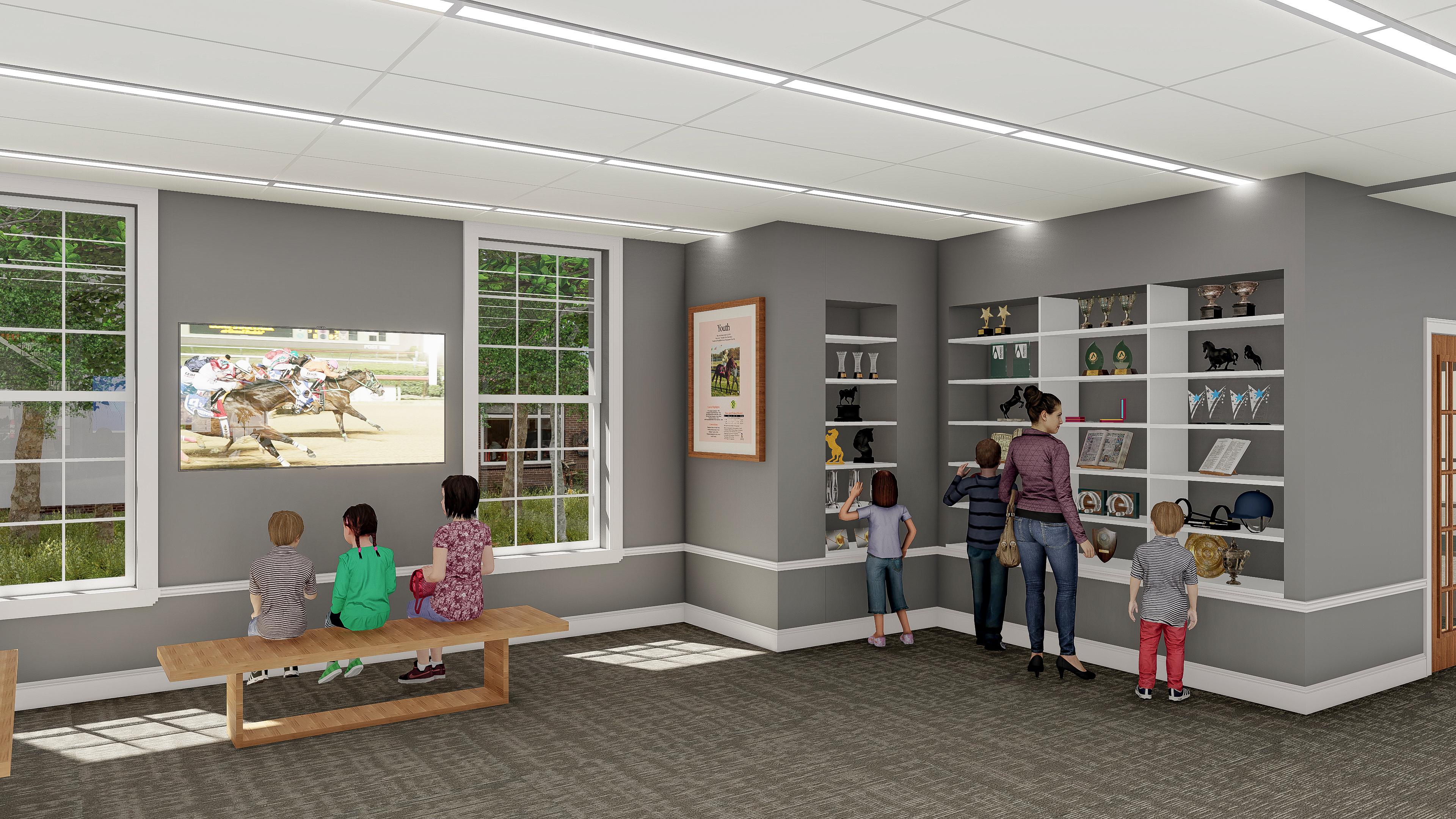
Golden Tempo Goes Last-to-First to Capture Lecomte Stakes at Fair Grounds

The Maryland Horse Breeders Association’s Sara Gordon sat down with Cricket Goodall, Josh Pons, and Richard F. Blue Jr. to discuss the history of the Maryland Horse Foundation, the MHBA’s charitable arm; the MHBA’s history of working to bring the various aspects of Maryland’s horse industry together; and the recent launch of the capital campaign for the MHF’s Maryland Horse Library & Education Center.
Cricket Goodall is the executive director of the MHBA, Josh Pons is a co-chair of the Maryland Horse Library & Education Center Capital Campaign and president of the MHF, and Richard F. Blue, Jr. is a co-chair of the Maryland Horse Library & Education Center Capital Campaign and vice president of the MHBA.
Executive Director of the Maryland Horse Breeders Association
Why was the Maryland Horse Foundation created?
Rich Wilcke, when he was executive director, started the foundation in 1988. He realized then that the Maryland Horse Breeders Association needed a 501(c)3, it needed a charitable arm, and it was at that point geared more towards education, to a certain extent, by helping industry issues, addressing them, and collecting donations that would help with that. It was probably then, in the 1980s, that Rich started thinking about a vehicle for people to donate books and memorabilia [to the library].
We’d had people donate stuff before, but back in the 1980s there wasn’t a focus on the incentive of a charitable donation — it was more because they had been on the board here and they’d leave us something — but then it became a focus with the foundation. However, the foundation sort of took time to find its way and really appeal to people, so I don’t think people really knew about it to donate stuff and I don’t think we got as much stuff as I had hoped. I really hoped people would do that, and there were some big breeders and industry people who died and we don’t know what happened to their stuff, and that’s a shame. But at the time, we just weren’t focused on or ready to say, ‘give us your trophies or your artwork.’ Now, I think the foundation’s ready to do that.
When did the MHF get more involved with educating the next generation?
About six years ago, I talked to Jordyn [Egan] and we decided to focus on the education part of the foundation. There were already rescues, aftercare, groups addressing substance abuse, so I thought we ought to work on education and encouraging people to look for careers in this business so that we could repopulate the business with good, smart people, so that’s when the Maryland Thoroughbred Career Program came to be.
That led to where we are today, because if the MHBA or groups like us don’t educate, you know we advocate, but you need to educate as well, it’s probably just as important. Educating and advocating in Annapolis are virtually the same thing. Educating in other ways is trying to encourage new people, younger people, to get involved and love what we do and want to get in in some way, whether it’s racehorses or any kind of horses, so I think that’s definitely paid off.
The MTCP has been just what we hoped, Jordyn’s experience really helped that come to fruition, she had enough experience to pull something like that together, and when she first started, I sort of really gave her the foundation to think about because it hadn’t been doing enough and we hadn’t had enough support. We were focused on the magazine and other things we do, but now the foundation is front and center.
How long has the idea of the Maryland Horse library been passed around?
We did have a library and we did have people come in and research — that was in the late 1980s, early 1990s, when people would actually go to a library and sit down with books — but it was before a lot of the stats were online, so we had chart books and we had Cindy [Deubler] to answer questions. We didn’t have a fancy place for it, in fact it was in the boardroom at the Padonia Road [location] where we had the library around the boardroom table.

Once the foundation started, the library had always fallen under that, to take donations and encourage funding. So, not that we didn’t have a library before 1988, but after that any expenses sort of were funneled through the foundation for books and other support materials. So, there’s always been a sense that we wanted to grow and, you know, have a good resource for people in Maryland, whether they were looking to write something or just look up horse records, so that was part of what our mission was, to help people get information. Then, over time, when we were at the second Padonia [road] office, where the library and the boardroom were the same thing, we found it was sometimes a conflict because people would want to be in the library and we’d be having meetings, so we always had in our mind to have a special area for a library or a building.
The building part of it, Rich Wilcke was the executive director when we started realizing that we needed a better home. Being in an office building on Padonia Road was not ideal, though it was convenient, but it had no character. So again, it probably wasn’t until the mid-1990s that there was a real sense of looking and trying to do something permanent. Instead, we moved a couple times.
We knew we wanted to do the library, so then we did have conversations with Middleburg, Va., the National Sporting Library & Museum down there, and sort of picked their brain, picked the head librarian’s brain, and looked at their site because it’s a really nice building. Understanding their financing and how they raised the money sort of got me more enthused, because they were happy to be partners with us on a lot of things. We discussed digitizing files, how best to coordinate as a reference library long term, so that gave us even more possibilities for our library.
Why did the MHBA decide to purchase the building in historic Reisterstown? What makes it such a great fit?
The boards, we visited the idea, we had been looking at buildings, but they seemed hesitant to make that final commitment. But it had to be the right building, too. We looked and looked and we were just not coming up with the right situation.
The building we’re in now, I ended up finding because it’s in an area that I frequent and it had character, and the board embraced it, so it would allow us to really showcase the library; I mean, that’s sort of always been the plan. It’s now morphed into — because it’s a good idea — an education center, meeting area, memorabilia [area], even more so than a museum.
I mean it’s not going to be everybody’s idea of a museum, we’re not going to have art collections and that sort of thing, just because we’re not big enough, but also I don’t know that we want to go to a museum yet, that’s just a whole other level. Let’s focus on a library and a meeting space and educating people.
Meeting spaces are really important. I learned that with the Baltimore County Ag Center, actually, because when the county built their building there, they didn’t know how many people would use it for meetings and, until COVID-19 hit, it was in use all the time. I think that this is appealing to people and people are going to say, in this day and age, since people can do a lot of research online, maybe they don’t need to go to a library, but if you have that and have a meeting room and you have seminars, or offer a reason for people to come to the building, it’s worth it.
Plus, this Reisterstown building actually is in a good location for just the general public driving by. It’s easily accessible, and that’s a huge appeal, because the other sites we’ve looked at would have taken more of an effort to get to. They were still accessible, on the campus of Goucher College or on the [Baltimore County] Ag Center, but I think this area, this situation we’re in now, is better because we’ll get people just driving by that say, ‘Hey, I saw that Maryland Horse sign,” and I don’t know if we would have gotten that before.
As the MHF proceeds with this project, what’s your vision?

I want this facility to host 4-H meetings, it could be any horse clubs, or the Maryland Horse Industry Board, the Maryland Horse Council, and it doesn’t have to be just horse-related – [it can be for] anybody that needs a place to meet, as far as I’m concerned. The AV that we’re putting in here will allow people to show a film if they have it, and with the media room I’m hoping that turns into a place where people can digitize what they have or sit down and leave audio memories of their time growing up.
I’d always wished we’d had a place to record oral history because it’s really important, and then we’ll have something where people could push a button and hear about some famous Marylanders we’ve got on the record. We’ve lost a lot of old-time trainers. I’ve heard stories, but I can’t tell them like they did, and I can’t tell them in the voice that they had, and now they’re gone. Like the King Leatherburys and the Bill Bonifaces, you need to hear them tell the stories. I think part of the plan is to capture that, so you’ve got history that now may be in these photo files or our archives in mini storage in our building, and you can hear it, see it, anybody can.
So, the library is basically, at this point, a collection of whatever we have had and anything that people would like to give us.
Why is the development of the Maryland Horse Library & Education Center so important to Maryland’s horse industry and the state in general?
There’s nothing else like this in Maryland, which is a shame, and shame on Maryland. They had a little sort of room at Pimlico, and if you went up in the press box, I don’t know what’s at Pimlico now, but they had a lot of really interesting stuff that was stacked on tables and in file cabinets, all the old photos and negatives. I don’t know what’s left up there but it’s a shame — there was just nobody at the time that was willing to take that on and say, ‘we’ve got to save this.’ There’s been talk, but there’s been nothing, and Maryland, I believe, has the strongest historic record of the horse industry, I mean it’s got an older history than Kentucky and Florida and everywhere else, and to have no place to acknowledge that is disturbing to say the least. And we can’t be that, we’re not going to be a Preakness museum, but we’ll be a little something, acknowledging what we have done, what the MHBA has done, and hopefully that’s going to spur whoever does the Preakness museum or does a bigger national-focus museum.
Going back to the focus of the foundation, it’s all about education and getting more people more interested in loving horses and the horse industry.
Co-Chair of the Maryland Horse Library & Education Center Capital Campaign and President of the Maryland Horse Foundation
What is so worthwhile about providing a combined library and education center?
We’ve been the beneficiaries of some remarkable donations that need to be open to the public. We have the Selima Room, the best of the books of William Woodward Sr., who had Bel Air Stud, and those books primarily, well most of them, are in the public storage warehouse in Timonium and they need to be shown and available to people as a resource. But the most important thing this effort will do will be to give us a place to teach young people about a way to live, with animals, on farms, that go to racetracks in cities. Without some feeder program, without a JV program for an athlete to get started in, which is similar to what we’re doing here, there’s no cultivating for the future of horse racing or breeding, which is really where we’re in peril, in a state that doesn’t have a lot of land in it and it doesn’t have a lot of people that want to take the trouble to raise Thoroughbred horses. It’s hard work. But if you could tap into the rich history of it and the rewarding lives it’s provided for a lot of breeders, just growing up and living on a farm in itself is a privilege.

I’m hoping that we focus on the educational aspects of it, since there’s a great history of Marylanders doing that. If you were to look back in the late 1930s, I think Chester Hockley and Humphrey Finney, they produced a movie called “Maryland Horse,” and Finney went around and he had an educational film that he took to classrooms around the state. So, it’s kind of like a legacy thing that people have paid attention to, and we have this opportunity with the new building. You couldn’t do this without a building. You could talk about it, which is what we’ve done for the entire existence of the MHBA, but it has never had its own building. It has always rented or lived in somebody’s house, like 1 Dixie Dr., where Finney kept his offices. But Cricket and the board, right before COVID-19 hit, made a very brave and long-lasting decision to put together a plan to buy a building, and the building is perfect.
How will this benefit Maryland and its residents?
If you’re interested in the horse business in Virginia, you go to Middleburg, you go to the National Sporting Library & Museum. If you’re interested in the horse business in Kentucky, you go to the Keeneland Library. If you’re interested in New York, you go to the Racing Museum and Hall of Fame in Saratoga, but if you’re interested in Maryland, you can’t go to a 12-foot room that’s closed off on the second floor of Pimlico and come away with much.
I mean, I worked at the BloodHorse off and on for seven years, and it had a great library and access to the Keeneland Library, and I mean people sat in there at the big conference table in the library all the time, famous people, like John Gaines would come in there and study how Federico Tesio did stuff. I mean, you have to have a place where you can learn, that’s really important. That’s the goal, I think, of this blended library and education center push, and I think it’s going to strike a very popular chord with a lot of Marylanders. I expect that most people will think hard and give what they can and then take advantage of it once it’s locked in place and filled out.
It’s important for the state to have an agriculture center that focuses just on the importance of horses, and it’s a really rich history. All you have to do is look back through Maryland Horse [magazines] and look at what we’re doing today. Farms are hanging on despite the shrinking foal crop and the national fear over whether trainers are playing by the rules — the whole WHOA (Water, Hay, Oats Alliance) movement — all that stuff is negative publicity for the most part and this is a positive story for the horse business, and the MHBA has taken the lead. It’s a great opportunity to maintain a position of leadership in the industry and have people say, ‘look what they’re doing in Maryland.’ We’re well-respected in the country in a different way than everybody else is.
Why is the MHBA owning its own building, providing a rightful home for the library and now education center, so momentous?
When I was president, we looked and looked and looked and we looked at farmhouses, and we thought Goucher College might work, then they changed presidents and the new guy didn’t have the emphasis on the equine stuff. We would have been a partner with somebody else, but with this building we’re our own boss, and that allows us to make the changes we think we can make without a whole bunch of bureaucracy or temporariness to it. Without a building, there’s no learning center.
It’s a blank slate. It’s a building that feels chapel-like. It has the presence of a place that is conducive to contemplation and reflection, that then helps you look forward, and the building being an [old church], right on the street with beautiful columns, I mean it looks like an educational building. If it could talk, it would tell you about all of the horse-drawn carriages that went in front of it for 50 years until the cars came, and then it’d tell you about who drove past on their way to the Maryland Hunt Cup, you know, on the way to the Preakness. And it’s located 15 minutes from a lot of farmland, so you could leave the building and go for a drive and really get a flavor for Maryland’s horse industry.
Co-Chair of the Maryland Horse Library & Education Center Capital Campaign and Vice President of the Maryland Horse Breeders Association
What does this project mean to you, as someone who has been a longtime member of Maryland’s horse industry?
The horse business, and racing business, it basically saved my life. I was not headed in the right direction and I got involved in the horse business through my grandparents, they lived on a horse farm. Well, maybe not saved my life, but got me headed in the right direction because I’m dyslexic and I also have ADD, and school work sucked. So, I went and worked on the horse farm and went to college and that’s how I got into it. I realized at that point, I said, ‘I’m not going to be a trainer, I want to be an owner,’ so I went out and started making money so I could own horses.
So, this project, to me, is a way of showing the youth and kids who may have learning differences, that this is a way they can vent in a different direction. It’s really something they’d have fun with. And also, it’s a way of honoring my grandparents, because they had a horse farm, bred their own horses, and they even had their own stallion.